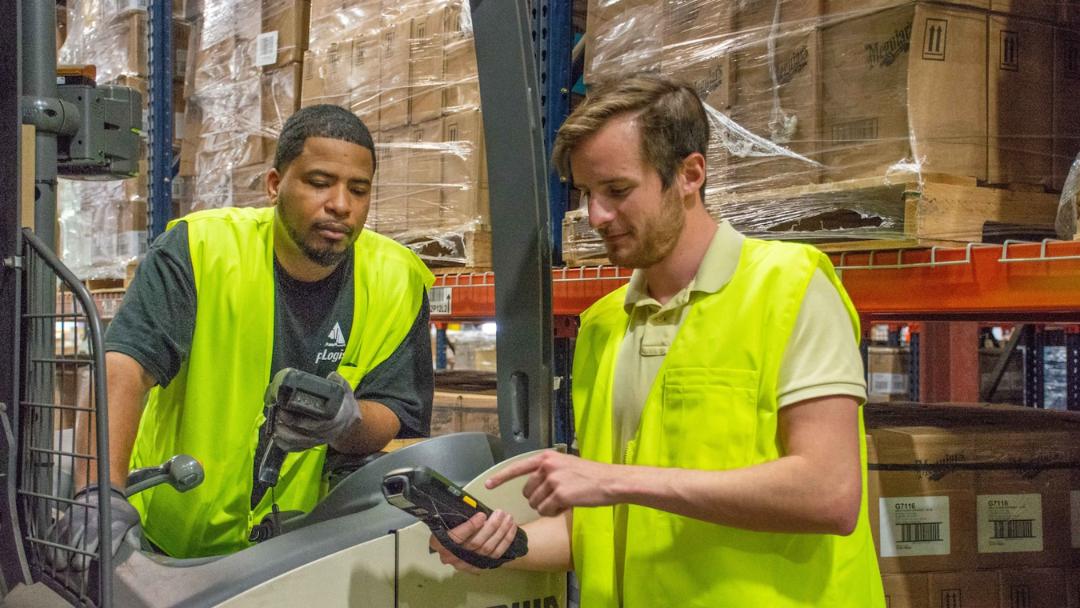Optimized logistics and supply chain management are at the heart of successful warehouse operations, but accomplishing this can prove challenging. Whether you’re an up-and-coming warehouse manager ready to boost your organization’s productivity or a seasoned professional who wants to optimize your current setup, there are a few key strategies that can help you reach new levels of warehouse efficiency.
Read on to learn more about the importance of warehouse optimization, the best practices to help you get there, and how you can confidently make your next career move in warehouse management.
Best practices for organizing your warehouse
If you’re in the business of warehouse management, there’s a good chance you hear the term warehouse optimization frequently, but it’s more than just a buzzword; it’s an essential component of success in the logistics and supply chain world. With a more efficient layout design, improved inventory management, and increased modern technology investments, warehouse managers promote several organizational benefits, including:
- Enhanced efficiency and streamlined processes which help to reduce handling time and strengthen overall productivity.
- Lower operational costs at the hands of improved space utilization and inventory control.
- Reduced errors in picking and shipping due to more accurate inventory management.
- Faster order fulfillment to help your team meet rising customer demands.
- Increased safety measures and limited warehouse accidents.
- Greater adaptability in the face of changing market demands.
- Improved customer satisfaction as your team maintains more accurate and timely deliveries long-term.
Taking actionable steps to boost warehouse organization and management is key to promoting operational performance and staying agile amid continuously evolving industries.
Who is in charge of organizing warehouses?
Warehouse managers or supervisors are in charge of organizing a warehouse and optimizing its operations. While these professionals are working toward maximum efficiency and effectiveness, some of the main tasks they oversee include:
- Warehouse layout design: Creating an efficient floor plan, organizing storage spaces, and facilitating smooth traffic flow within the warehouse.
- Inventory management: Introducing systems for inventory control, categorizing items, and maintaining accurate stock levels.
- Personnel management: Hiring, training, and supervising warehouse workers, making sure every team member is equipped to succeed and follow the proper safety protocols.
- Technology integration: Supervising the implementation of emerging technologies that support warehouse optimization, such as automation, IoT sensors, robotics, and RFID systems.
- Continuous improvement: Identifying opportunities for improvement and making updates as needed.
The steps for successful warehouse optimization
Effective warehouse organization is a critical component of greater productivity, supporting seamless inventory flow and operational efficiency. There are three major steps warehouse managers and their teams can take to drive warehouse performance:
- Evaluate your existing warehouse layout and arrangement: Start by conducting a thorough assessment of the warehouse setup you currently have in place, identifying areas of improvement.
- Establish clear objectives for your warehouse structure and operation: Next, take the time to communicate the goals of your warehouse optimization efforts. This is important to establish more specific performance benchmarks or efficiency targets.
- Implement changes to enhance your organizational strategy: Finally, redesign your warehouse layout for improved inventory flow and space utilization, introducing new technologies and automation where relevant, to boost overall efficiency and productivity.
6 best practices for driving warehouse organization and optimization
As a manager or team leader in the warehousing space, you can quickly take your operations to the next level by implementing best practices in warehouse organization and management. Consider the following key strategies:
1. Implement the right warehouse equipment and technology
Modern order fulfillment and distribution operations are increasingly supported by advancements in automation technologies and warehouse management systems. With a wide range of tailored software and automation solutions available to improve the storage, movement, sorting, and shipping of your inventory, it’s critical to invest in the right tools. Here are some of the most popular options today:
- Automated storage and retrieval systems.
- Radio Frequency Identification (RFID) systems.
- IoT sensors.
- Robotics and automation.
- Predictive analytics.
2. Automate data collection
Introduce emerging solutions that enable automatic data collection like barcode scanners or inventory management software. This minimizes manual input errors and provides real-time insights for more informed decision-making. Its time-saving benefits can also prove to be invaluable, as over 40% of workers spend at least a quarter of their workweek on manual, repetitive tasks, according to Smartsheet.
3. Minimize touch points
According to Conveyco, team members walking and manually picking orders can account for more than 50% of the time associated with picking. Reducing the number of times an item is handled not only frees up team members for value-adding activities, it also minimizes the risk of inventory damage and speeds up order fulfillment. This can be achieved by implementing more efficient routing and packing methods such as zone, wave, batch, or cluster picking.
4. Carefully zone your inventory
To minimize travel time for your employees and improve picking accuracy, it’s best practice to arrange products into logical zones. This often includes clearly marked sections based on product type, demand, or size.
5. Ensure vendor compliance
Collaborating closely with suppliers and maintaining consistent, quality, and timely deliveries is the best way to foster strong working relationships within the industry. In addition to helping your team ensure industry compliance standards, this is an effective strategy to reduce potential supply chain disruptions.
6. Prioritize warehouse safety
Emphasizing and creating a safe workplace is critical to protecting employees, minimizing both warehouse accidents and costly disruptions. Invest in regular safety training, equipment maintenance, and compliance audits to ensure you’re maintaining the safest possible environment.
Promoting warehouse success long-term
Building a thriving warehouse requires both long-term dedication and investment. Some methods that can be used to improve your warehouse organization include:
- Leverage regular warehouse audits and assessments: A structured system to identify inefficiencies and improve processes is a great way to enhance your warehouse’s overall performance. You can schedule routine audits and assessments, involving cross-functional teams, to recommend improvements and enable ongoing optimization.
- Implement feedback loops and encourage employee engagement: By establishing clear channels for team members to share their insights, actively listening to their input, and creating a supportive environment where suggestions are valued, you can harness the collective knowledge and experience of your workforce. This helps drive innovation and adaptability.
- Adapt quickly to changing demands: To remain competitive and meet evolving customer expectations, it’s important to prioritize agility, invest in technology that supports adaptability, and implement a responsive supply chain and workforce strategy.
Find your next role in warehouse management
Warehouse managers and assemblers are in high demand today due to growing complexities in supply chains, the recent accelerated surge in e-commerce, and the increasing need for more efficient inventory management.
As warehouse and logistics environments become more intricate, skilled warehouse managers play a central role in achieving top-notch organization — making their expertise highly sought after. In fact, a report from LinkedIn projects considerable growth in this field as it continues to play a crucial role on the frontlines of e-commerce.
If you’re ready to make your next professional move in the world of warehousing, Employbridge can help. At Employbridge, we’re dedicated to connecting qualified talent with rewarding positions at leading companies across the nation. With competitive salaries, comprehensive benefits, and an emphasis on well-being, we’re here to help you develop a successful career.
Explore all of our career opportunities or contact us to learn more about how we can help you make your next professional move with confidence.


